![]() a city official
a city official
 JP | EN
JP | EN
 JP | EN
JP | EN
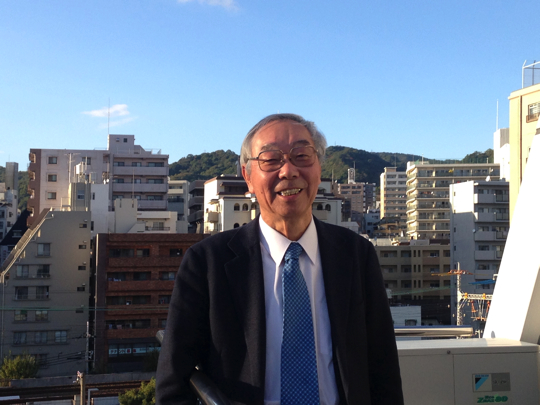
Since the earthquake, city officials have collaborated with the affected citizens to rebuild the city. There were many Kobe citizens who took action on their own instead of waiting for the city to help them. The successful management of 600 evacuation shelters is one such example of collaboration.
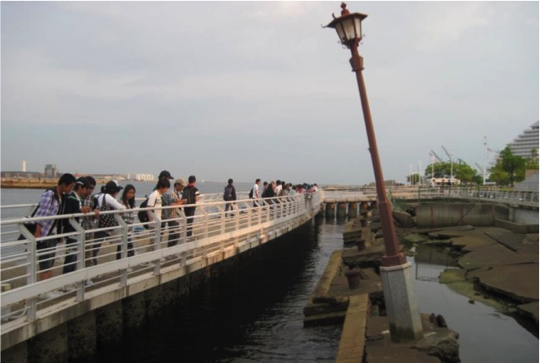 Photo: Students of a field trip from Nagoya City’s Shiroyama Junior High School visit the Port of Kobe Earthquake Memorial Park, a disaster site in Meriken Park, guided by K-TEC
Photo: Students of a field trip from Nagoya City’s Shiroyama Junior High School visit the Port of Kobe Earthquake Memorial Park, a disaster site in Meriken Park, guided by K-TECThere was no GPS at that time, so officials walked around the city for two days. They had to continue their investigation without helping injured people under collapsed buildings, which must have been hard for them. But we could not get any support from the government without a disaster damage map.
We created a land rezoning plan and a city redevelopment business plan under the policy of economical activation, small and medium-sized business reconstruction, recovery of social infrastructure, as well as with the aim to build a safe and disaster-resistant new city. In order to realize our plans, we asked the people whose houses were damaged to wait for two months to start reconstructing their houses, and asked them to offer pieces of their land, which was criticized by the mass media.
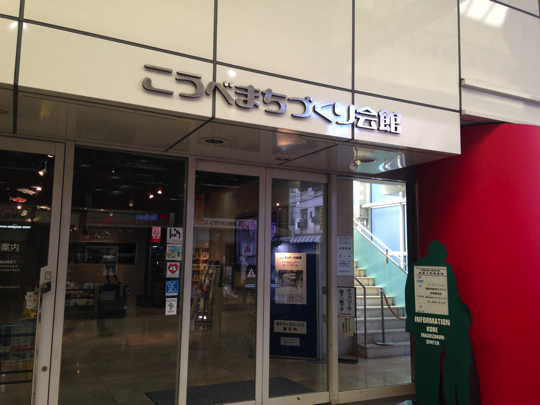 Photo: Kobe Housing and Urban Development Hall, the center of city planning since the earthquake
Photo: Kobe Housing and Urban Development Hall, the center of city planning since the earthquakeThe city administration and disaster victims tend to be polarized, and even one single technical term can cause misunderstanding. The City Planning Conference sometimes had to stand between the two parties to “translate” in order to have a smooth conversation.
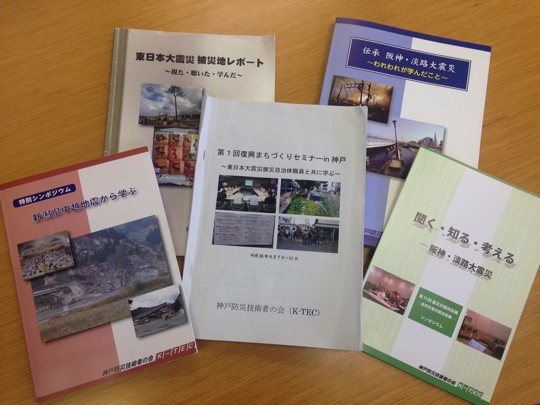 Photo: Report booklets by K−TEC
Photo: Report booklets by K−TECWe always tried to create something with the victims of the earthquake and the store owners of shopping streets by trying hard but also while enjoying ourselves. Although it might be an overstatement to say that because of the sufferers’ efforts we could follow their lead, it was a true collaboration.
 Photo: Mr. Katase at work with the citizens at Infiorata Kobe (the man in the center in the back, photograph provided by Kobe City)
Photo: Mr. Katase at work with the citizens at Infiorata Kobe (the man in the center in the back, photograph provided by Kobe City)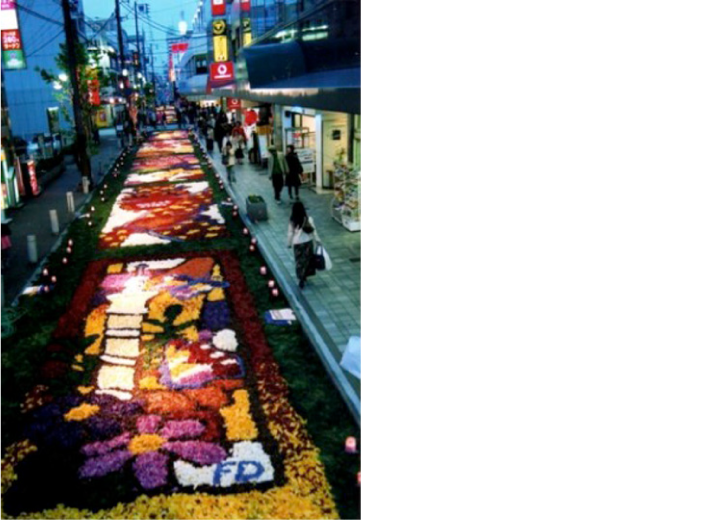 Photo: At Infiorata Kobe, flowers form pictures on the streets (photograph provided by Kobe City)
Photo: At Infiorata Kobe, flowers form pictures on the streets (photograph provided by Kobe City)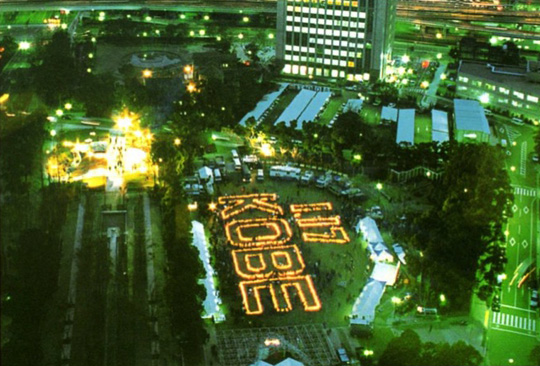 Photo: Bamboo lanterns of 1.17 (photograph provided by Kobe City)
Photo: Bamboo lanterns of 1.17 (photograph provided by Kobe City)When I retired from Kobe City Hall, I was told by the former Mayor Kazutoshi Sasayama to take over the role of repaying the citizens and the people in Japan for their support and showing our appreciation.
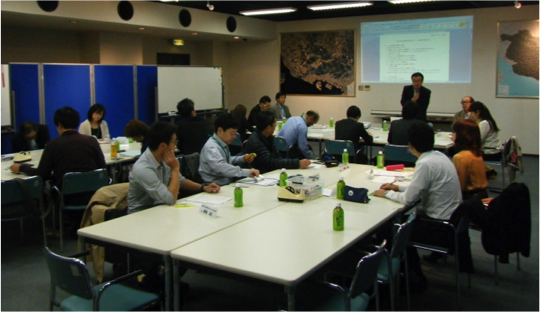 Photo: Earthquake Disaster Reconstruction Interchange Seminar in Kobe (2014.10.30)
Photo: Earthquake Disaster Reconstruction Interchange Seminar in Kobe (2014.10.30)I especially want young city officials to understand the appropriate actions, dealings, and measures of each bureau during a disaster. When we go to the disaster-hit areas of the 2004 Chuetsu Earthquake or the 2011 Great East Japan Earthquake, we are regarded as experts because we are from Kobe. Retired officials can be helpful because we need to be able to answer any questions.
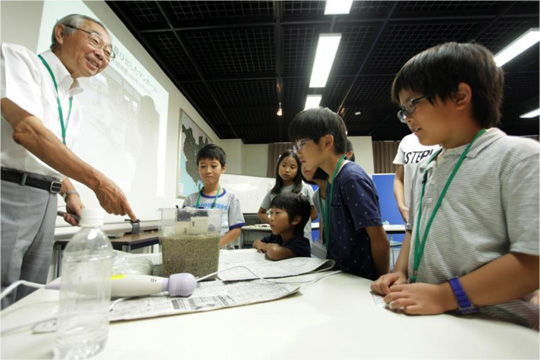 Photo: Mr. Katase explains liquefaction to children. He works hard to teach children how to minimize disasters.
Photo: Mr. Katase explains liquefaction to children. He works hard to teach children how to minimize disasters.Heavy rainfall occurred in July the year after I joined City Hall. At that time, there were some officials who had experienced the Bombing of Kobe, which burned around 80 percent of Kobe city center, and some who had worked on land zoning after the war. Former Mayor Sasayama was one of those who experienced the reconstruction after the war. Because Kobe city officials including myself had inherited the DNA to deal with crisis and to prevent disaster, we could succeed in the reconstruction after the earthquake, and there are officials who are willing to take part in associations like K-TEC.
Mount Rokko used to be a bald mountain 100 years ago because of overuse of wood during the Edo Period, but the citizens and the government planted trees to protect against rock-slides. The citizens and the government have inherited the DNA to collaborate and create ways to protect our lives.
We have to protect our own lives. What the government can do is limited. Citizens, companies, and the government should work together to create a disaster-free city. I would especially like young people to take part in K-TEC to study together.
Norio Katase
Born in Kobe City, Hyogo Prefecture in 1943 and grew up in Tamba City. He graduated from the Faculty of Engineering at Kanazawa University. He started working as a Kobe municipal officer in April 1966. He became the Manager of the Engineering Section in the Planning Department at the City Planning Bureau in 1994, the Deputy Ward Director of Chuo Ward in April 1995, the Director of the Planning Department in the City Planning Bureau in 1997, the Director of the Road Department in the Construction Bureau in 2001, and the Ward Director of Chuo Ward in 2002. He retired in 2004, and founded K-TEC (Kobe Technical Experts Co-operative Association for Disaster Prevention) in June that year. He studies methods of passing down stories of the Great Hanshin-Awaji Earthquake to Kobe municipal officials, other local government officials in Japan, and young people; support and relief measures at disaster sites; and risk management.